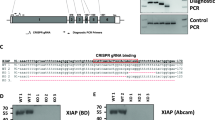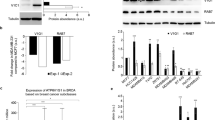Abstract
The tumour suppressor adenomatous polyposis coli (APC) is mutated in sporadic and familial colorectal tumours1,2. APC binds to β-catenin, a key component of the Wnt signalling pathway, and induces its degradation1,2,3,4,5. APC interacts with microtubules and accumulates at their plus ends in membrane protrusions6,7,8,9, and associates with the plasma membrane in an actin-dependent manner10. In addition, APC interacts with the Rac-specific guanine nucleotide exchange factor Asef and stimulates its activity, thereby regulating the actin cytoskeletal network and cell morphology11. Here we show that overexpression of Asef decreases E-cadherin-mediated cell–cell adhesion and promotes the migration of epithelial Madin–Darby canine kidney cells. Both of these activities are stimulated by truncated APC proteins expressed in colorectal tumour cells. Experiments based on RNA interference and dominant-negative mutants show that both Asef and mutated APC are required for the migration of colorectal tumour cells expressing truncated APC. These results suggest that the APC–Asef complex functions in cell migration as well as in E-cadherin-mediated cell–cell adhesion, and that truncated APC present in colorectal tumour cells contributes to their aberrant migratory properties.
This is a preview of subscription content, access via your institution
Access options
Subscribe to this journal
Receive 12 print issues and online access
$209.00 per year
only $17.42 per issue
Buy this article
- Purchase on Springer Link
- Instant access to full article PDF
Prices may be subject to local taxes which are calculated during checkout




Similar content being viewed by others
References
Kinzler, K.W. & Vogelstein, B. Lessons from hereditary colorectal cancer. Cell 87, 159–170 (1996).
Fearnhead, N.S., Britton, M.P. & Bodmer, W.F. The ABC of APC. Hum. Mol. Genet. 10, 721–733 (2001).
Bienz, M. & Clevers, H. Linking colorectal cancer to Wnt signaling. Cell 103, 311–320 (2000).
Peifer, M. & Polakis, P. Wnt signaling in oncogenesis and embryogenesis — look outside the nucleus. Science 287, 1606–1609 (2000).
Akiyama, T. Wnt/β-catenin signaling. Cytokine Growth Factor Rev. 11, 273–282 (2000).
Munemitsu, S. et al. The APC gene product associates with microtubules in vivo and promotes their assembly in vitro. Cancer Res. 54, 3676–3681 (1994).
Smith, K.J. et al. Wild-type but not mutant APC associates with the microtubule cytoskeleton. Cancer Res. 54, 3672–3675 (1994).
Nathke, I.S., Adams, C.L., Polakis, P., Sellin, J.H. & Nelson, W.I.J. The adenomatous polyposis coli tumor suppressor protein localizes to plasma membrane sites involved in active cell migration. J. Cell Biol. 134, 165–179 (1996).
Mimori-Kiyosue, Y., Shiina, N. & Tsukita, S. Adenomatous polyposis coli (APC) protein moves along microtubules and concentrates at their growing ends in epithelial cells. J. Cell Biol. 148, 505–518 (2000).
Rosin-Arbesfeld, R., Ihrke, G. & Bienz, M. Actin-dependent membrane association of the APC tumor suppressor in polarized mammalian epithelial cells. EMBO J. 20, 5929–5939 (2001).
Kawasaki, Y. et al. Asef, a link between the tumor suppressor APC and G-protein signaling. Science 289, 1194–1197 (2000).
Hall, A. Rho GTPase and the actin cytoskeleton. Science 279, 509–514 (1998).
Van Aelst, L. & D'Souza-Schorey, C. Rho GTPases and signaling network. Genes Dev. 11, 2295–2322 (1997).
Whitehead, I.P., Campbell. S., Rossman, K.L. & Der, C.J. Dbl family proteins. Biochim. Biophys. Acta 1332, F1–F23 (1997).
Keely, P.J., Westwick, J.K., Whitehead, I.P., Der, C.J. & Parise, L.V. Cdc42 and Rac1 induce integrin-mediated cell motility and invasiveness through PI(3)K. Nature 390, 632–636 (1997).
Sander, E.E. et al. Matrix-dependent Tiam1/Rac signaling in epithelial cells promotes either cell–cell adhesion or cell migration and is regulated by phosphatidylinositol 3-kinase. J. Cell Biol. 143, 1385–1398 (1998).
Hordijk, P.L. et al. Inhibition of invasion of epithelial cells by Tiam1–Rac signaling. Science 278, 1464–1466 (1997).
Takaishi, K., Sasaki, T., Kotani, H., Nishioka, H. & Takai, Y. Regulation of cell–cell adhesion by Rac and Rho small G proteins in MDCK cells. J. Cell Biol. 139, 1047–1059 (1997).
Braga, V.M.M. Betson, M., Li, X. & Lamarche-Vane, N. Activation of the small GTPase Rac is sufficient to disrupt cadherin-dependent cell–cell adhesion in normal human keratinocytes. Mol. Biol. Cell 11, 3703–3721 (2000).
Miyoshi, Y. et al. Somatic mutation of the APC gene in colorectal tumors: mutation cluster region in the APC gene. Hum. Mol. Genet. 1, 229–233 (1992).
Nagawa, H. & Nakamura, Y. Mutations of the APC (adenomatous polyposis coli) gene. Hum. Mutat. 2, 425–434 (1993).
Paddison, P.J., Caudy, A.A., Bernstein, E., Hannon, G.J. & Conklin, D.S. Short hairpin RNAs (shRNAs) induce sequence-specific silencing in mammalian cells. Genes Dev. 16, 948–958 (2002).
Rowan, A.J. et al. APC mutation in sporadic colorectal tumors: a mutational hotspot and interdependence of the two hit. Proc. Natl Acad. Sci. USA 97, 3352–3357 (2000).
Wong, M.H., Hermiston, M.L., Syder, A.J. & Gordon, J.I. Forced expression of the tumor suppressor adenomatous polyposis coli protein induces disordered cell migration in the intestinal epithelium. Proc. Natl Acad. Sci. USA 93, 9588–9593 (1996).
Oshima, H., Oshima, M., Kobayashi, M., Tsutsumi, M., Taketo, M.M. Morphological and molecular processes of polyp formation in Apc (Δ716) knockout mice. Cancer Res. 57, 1644–1649 (1997).
Klemke, R.L. et al. Regulation of cell motility by mitogen-activated protein kinase. J. Cell Biol. 137, 481–492 (1997).
Sells, M.A., Boyd, J.T. & Chernoff, J. p21-activated kinase 1 (Pak1) regulates cell motility in mammalian fibroblasts. J. Cell Biol. 145, 837–849 (1999).
Acknowledgements
We thank G. J. Hannon for pSHAG-1, and M. Lamphier for reading the manuscript. This work was supported by Grants-in-Aid for Scientific Research on Priority Areas and the Organization for Pharmaceutical Safety and Research.
Author information
Authors and Affiliations
Corresponding author
Ethics declarations
Competing interests
The authors declare no competing financial interests.
Rights and permissions
About this article
Cite this article
Kawasaki, Y., Sato, R. & Akiyama, T. Mutated APC and Asef are involved in the migration of colorectal tumour cells. Nat Cell Biol 5, 211–215 (2003). https://doi.org/10.1038/ncb937
Received:
Revised:
Accepted:
Published:
Issue Date:
DOI: https://doi.org/10.1038/ncb937
This article is cited by
-
Mutant APC reshapes Wnt signaling plasma membrane nanodomains by altering cholesterol levels via oncogenic β-catenin
Nature Communications (2023)
-
Rational design of a sensitivity-enhanced tracer for discovering efficient APC–Asef inhibitors
Nature Communications (2022)
-
Mutational drivers of cancer cell migration and invasion
British Journal of Cancer (2021)
-
Ubiquitylation and degradation of adenomatous polyposis coli by MKRN1 enhances Wnt/β-catenin signaling
Oncogene (2018)
-
Peptidomimetic inhibitors of APC–Asef interaction block colorectal cancer migration
Nature Chemical Biology (2017)



